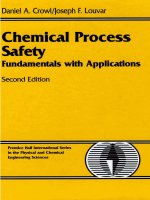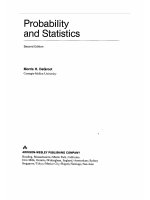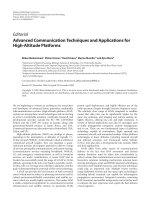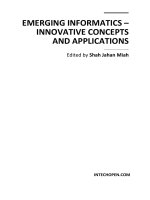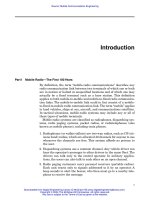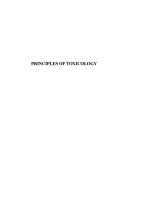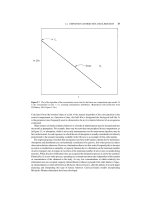Ecological Informatics Scope, Techniques and Applications 2nd Edition pptx
Bạn đang xem bản rút gọn của tài liệu. Xem và tải ngay bản đầy đủ của tài liệu tại đây (6.64 MB, 509 trang )
Friedrich Recknagel (Ed.)
Ecological Informatics
Scope, Techniques and Applications
Friedrich Recknagel (Ed.)
Ecological Informatics
Scope, Techniques and Applications
2nd Edition
With 174 Figures and a CD-ROM
EDITOR
A
SSOCIATE PROFESSOR FRIEDRICH RECKNAGEL
S
CHOOL OF EARTH AND ENVIRONMENTAL SCIENCES
T
HE UNIVERSITY OF ADELAIDE
5005
AUSTRALIA
E-mail:
ISBN 3-540-43455-0 Springer Berlin Heidelberg New York 1st edition 2003
ISBN 10 3-540-28383-8 Springer Berlin Heidelberg New York
ISBN 13 978-3540-28383-6 Springer Berlin Heidelberg New York
Library of Congress Control Number: 2005930717
This work is subject to copyright. All rights are reserved, whether the whole or part of the material is
concerned, specifically the rights of translation, reprinting, reuse of illustrations, recitation, broad-
casting, reproduction on microfilm or in any other way, and storage in data banks. Duplication of
this publication or parts thereof is permitted only under the provisions of the German Copyright Law
of September 9, 1965, in its current version, and permission for use must always be obtained from
Springer-Verlag. Violations are liable to prosecution under the German Copyright Law.
Springer is a part of Springer Science+Business Media
springeronline.com
Springer-Verlag Berlin Heidelberg 2006
Printed in Germany
The use of general descriptive names, registered names, trademarks, etc. in this publication does not
imply, even in the absence of a specific statement, that such names are exempt from the relevant pro-
tective laws and regulations and therefore free for general use.
Cover design: E. Kirchner, Heidelberg
Production: A. Oelschläger
Typesetting: Camera-ready by the Editor
Printing: Stürtz AG, Gemany
Binding: Stürtz AG, Germany
Printed on acid-free paper 30/2132/AO 5 4 3 2 1 0
This eBook does not include ancillary media that was packaged with
the printed version of the book.
To Karina, Melanie, Natalie and Philipp
Preface 2
nd
Edition
Ecological informatics (ecoinformatics) is an interdisciplinary framework for the
processing, archival, analysis and synthesis of ecological data by advanced
computational technology (Recknagel 2003). Processing and archival of
ecological data aim at facilitating data standardization, retrieval and sharing by
means of metadata and object-oriented programming (e.g. Michener et al. 1997;
Dolk 2000; Sen 2003; Eleveld, Schrimpf and Siegert 2003). Analysis and
synthesis of ecological data aim at elucidating principles of information
processing, structuring and functioning of ecosystems, and forecasting of
ecosystems behaviours by means of bio-inspired computation (e.g. Fielding 1999;
Lek and Guegan 2000; Recknagel 2003).
Ecological informatics currently undergoes the process of consolidation as a
discipline. It corresponds and partially overlaps with the well-established
disciplines bioinformatics and ecological modeling but is taking its distinct shape
and scope. In Fig. 1 a comparison is made between ecological informatics and
bioinformatics. Even though both are based on the same computational technology
their focus is different. Bioinformatics focuses very much on determining gene
function and interaction (e.g. Overbeck et al. 1999; Wolf et al. 2001), protein
structure and function (e.g. Henikoff et al. 1999; Lupas, Van Dyke and Stock
1991) as well as phenotype of organisms utilizing DNA microarray, genomic,
physiological and metabolic data (e.g. Lockhardt and Winzeler 2000) (Fig. 1a). By
contrast ecological informatics focuses to determine population function and
interactions as well as ecosystem structure and functioning by utilizing genomic,
phenotypic, community, environmental and climate data (e.g. D’Angelo et al.
1995; Chon et al. 2003; Park et al. 2003, Jeong, Recknagel and Joo 2003) (Fig.
1b).
A comparison is made between ecological modeling and ecological informatics
in Fig. 2. Even though both rely on similar ecological data they adopt different
approaches in utilizing the data. Whilst ecological modeling processes ecological
data top down by ad hoc designed statistical or mathematical models (e.g.
Straskraba and Gnauck 1985; Jorgensen 1994), ecological informatics infers
ecological processes from ecological data patterns bottom up by computational
techniques. The cross-sectional area between ecological modeling and ecological
informatics reflects a new generation of hybrid models that enable to predict
emergent ecosystem structures and behaviours, and ecosystem evolution (e.g.
Booth 1997; Downing 1997; Hraber and Milne 1997; Huse, Strand and Giske
1999). Typically those models embody biologically-inspired computation in
deterministic ecological models.
Preface
VIII
Figure 1. Ecological informatics versus bioinformatics, a) Scope of
bioinformatics (modified from Oltvai and Barabasi (2002)), b) Scope of
ecoinformatics
Preface
IX
Figure 2. Ecological informatics versus ecological modeling
The term ecological informatics was suggested at the International Conference
on Applications of Machine Learning to Ecological Modelling in 2000 (see
Ecological Modelling 2001, 195) when the International Society for Ecological
Informatics ISEI (www.waite.Adelaide.edu.au/ISEI) was founded. Since then an
increasing number of researchers and research groups identify with this area, and
biennial international conferences are organized by the ISEI. Also the new journal
Ecological Informatics will be issued by Elsevier in October 2005
(www.elsevier.com/locate/ecolinf).
The contents of the 2
nd
edition of the book Ecological Informatics has been
revised and extended. Two new chapters have been added to Part I: Introduction.
Chapter 2 by Bredeweg et al. provides an introduction to the novel concept of
qualitative reasoning that emerges as an alternative approach to fuzzy logic for
automated processing and utilizing of heuristic ecological knowledge. Exemplary
applications to population and community dynamics illustrate the potential of the
approach. Chapter 7 by Tempesti et al. addresses the novel concept of self-
Ecological Informatics
High Performance Computing
Biologically-Inspired Computation
Object-Oriented Data
Internet
Ecological Modelling
Differential Equations
Thermodynamics
Multivariate Statistics
Heuristics
Ecology
Biosphere
Ecosystems
Communities
Populations
Organisms
Cells
Genes
Top-Down
Empirical and
Deterministic
Approach
Bottom-Up
Neural and
Evolutionary
Approach
Hybrid
Approach
Ecological Informatics
High Performance Computing
Biologically-Inspired Computation
Object-Oriented Data
Internet
Ecological Informatics
High Performance Computing
Biologically-Inspired Computation
Object-Oriented Data
Internet
Ecological Modelling
Differential Equations
Thermodynamics
Multivariate Statistics
Heuristics
Ecology
Biosphere
Ecosystems
Communities
Populations
Organisms
Cells
Genes
Top-Down
Empirical and
Deterministic
Approach
Bottom-Up
Neural and
Evolutionary
Approach
Hybrid
Approach
Preface
X
replicating cellular automata inspired by the nature of the genome as the
hereditary information of an organism. The authors demonstrate how self-
replicating cellular automata can be explored for the design of nano-scale circuits
for computer hardware. The paper contributes to the fast growing research on bio-
inspired design of both computer software and hardware.
Three new chapters have been added to Part IV: Prediction and Elucidation of
Lake and Marine Ecosystems. Chapter 16 by Recknagel et al. presents an
integrated approach of super- and non-supervised artificial neural networks
(ANN) for understanding and forecasting of phytoplankton population dynamics
in limnological time series data. The authors complement qualitative ordination
and clustering by non-supervised ANN with sensitivity curves from supervised
ANN to reveal complex ecological relationships. They apply recurrent supervised
ANN for 7-days-ahead forecasting of algal species abundances and succession.
Chapter 17 by Cao et al. introduces hybrid evolutionary algorithms (HEA) as
powerful tools for the discovery of predictive rule sets. The underlying algorithms
optimize both the rule structures and multiple parameters. The authors
demonstrate that the rule sets discovered in complex limnological time series data
achieve not only highly accurate 7-days-ahead forecasting of algal species
abundances and succession but provide a high degree of explanation by means of
THEN- and ELSE-branch specific sensitivity analysis. A CD with a demo version
of HEA is attached and instructions for HEA can be found in the Appendix.
Chapter 20 by Atanasova et al. demonstrates computational assemblage of
ordinary differential equations (ODE) based on an ecological process function
library and measured ecological data. The authors document automatically
assembled ODE for chlorophyll a in a lake and related validation results that
indicate possibilities and limitations of the approach.
I want to thank all of the authors who contributed to the book with great
enthusiasm and delivered on time. Finally I express my thanks to Dr. Christian
Witschel and Agata Oelschlaeger of the Geosciences Editorial Team of the
Springer-Verlag for their close collaboration in producing the book
References:
Booth, G., 1997. Gecko: A continuous 2D world for ecological modeling. Artificial Life 3,
147-163.
Chon, T S., Park, Y.S., Kwak, I S. and E.Y. Cha, 2003. Non-linear approach to grouping,
dynamics and organizational informatics of benthic macroinvertebrate communities in
streams by artificial neural networks. In: Recknagel, F. (ed.), 2003. Ecological
Informatics. Understanding Ecology by Biologically-Inspired Computation. Springer-
Verlag, Berlin, Heidelberg, New York, 127-178.
D’Angelo, D.J., Howard, L.M., Meyer, J.L., Gregory, S.V. and L.R. Ashkenas, 1995.
Ecological uses of genetic algorithms: predicting fish distributions in complex physical
habitats. Can.J.Fish.Aquat.Sci. 52, 1893-1908.
Dolk, D.R., 2000. Integrated model management in the data warehouse area. European
Journal of Operational Research 1222, 1999-218.
Downing, K., 1997. EUZONE: Simulating the evolution of aquatic ecosystems. Artificial
Life 3, 307-333.
Preface
XI
Eleveld, M.A., Schrimpf, W.B.H. and A.G. Siegert, 2003. User requirements and
information definition for the virtual coastal and marine data warehouse. Ocean &
Coastal Management 46, 487-505.
Fielding, A., 1999. Machine Learning Methods for Ecological Applications. Kluwer, 1-262.
Henikoff, S., Henikoff, J.G. and S. Pietrovski, 1999. Blocks+: a non-redundant database of
protein alignment blocks derived from multiple compilations. Bioinformatics 15, 471-
479.
Hraber, P. and B.T. Milne, 1997. Community assembly in a model ecosystem. Ecological
Modelling 103, 267-285.
Huse, G., Strand, E. and J. Giske, 1999. Implementing behaviour in individual-based
models using neural networks and genetic algorithms. Evolutionary Ecology 13, 469-
483.
Jeong, K S., Recknagel, F. and G J. Joo, 2003. Prediction and elucidation of population
dynamics of the blue-green algae Microcystis aeruginosa and the diatom Stephanodiscus
hantzschii in the Nakdong River-Reservoir System (South Korea) by a recurrent artificial
neural network. In: Recknagel, F. (ed.), 2003. Ecological Informatics. Understanding
Ecology by Biologically-Inspired Computation. Springer-Verlag, Berlin, Heidelberg,
New York, 195-213.
Jorgensen, S.E., 1995. Fundamentals of Ecological Modelling. Elsevier, Amsterdam, 1-628.
Lek, S. and J-F. Guegan (eds.), 2000. Artificial Neuronal Networks. Application to Ecology
and Evolution. Springer, Berlin, Heidelberg, New York, 1-262.
Lockhardt, D. and E. Winzeler, 2000. Genomics, gene expression and DNA arrays. Nature
405, 827-836.
Lupas, A., Van Dyke, M. and J. Stock, 1991. Predicting coiled coils from protein
sequences. Science 252, 1162-1164.
Michener, W.K., Brunt, J.W., Helly, J.J., Kirchner, T.B., and S.G.Stanford, 1997.
Nongeospatial metadata for the ecological sciences. Ecological Applications 7, 1, 330-
342.
Oltavai, Z.N. and A L. Barabasi, 2002. Life’s complexity pyramid. Science 298, 763-764.
Overbeck , R., Fonstein, M., D’Souza, M., Pusch, G.D. and N. Maltsev, 1999. The use of
gene clusters to infer functional coupling. Proc. Natl. Acad. Sci.
USA 96, 2896-2901.
Park, Y S., Verdonschot, P.F.M., Chon, T s., and S. Lek, 2003. Patterning and predicting
aquatic macroinvertebrate diversities using artificial neural networks. Water Research 37,
1749-1758.
Recknagel, F. (ed.), 2003. Ecological Informatics. Understanding Ecology by
Biologically-Inspired Computation. Springer-Verlag, Berlin, Heidelberg, New York.
Sen, A., 2003. Metadata management: past, present and future. Decision Support Systems
1043, 1-23
Straskraba, M. and A. Gnauck, 1985. Freshwater Ecosystems: Modelling and Simulation.
Elsevier, Amsterdam, 1-302.
Wolf, Y.I., Rogozin, I.B., Kondrashov, A.S. and E.V. Koonin, 2001. Genome alignment,
evolution of prokaryotic genome organization, and prediction of gene function using
genomic context. Genome Research 11, 356-372.
Friedrich Recknagel
Adelaide, 15 May 2005
Preface
XIII
Preface 1
st
Edition
In the 50s and 60s cross-sectional data of lake surveys were utilized for steady
state assessments of the eutrophication status of lakes by univariate nonlinear
regression. This statistical approach (see Table 1) became exemplary for river,
grassland and forest models and - because of simplicity - widespread for
classification of ecosystems.
In the 70s and 80s multivariate time series data were collected from ecosystems
such as lakes, rivers, forests and grasslands in order to improve understanding of
ecosystem dynamics. Process-based differential equations were used for the
computer simulation of food web dynamics and functional group succession. This
differential equation approach (see Table 1) is still widely used for scenario
analysis.
Table 1. Concepts for Ecosystems Analysis, Synthesis and Forecasting
1
Sakamoto M (1966) Primary production by phytoplankton community in some Japanese
lakes and its dependence on lake depth. Arch. Hydrobiol. 62, 1-28
2
Dillon P, Rigler F (1974) The phosphorus-chlorophyll relationship in lakes.
Limnol.Oceanogr. 19, 135-148
Ecosystem ForecastingScenario AnalysisEcosystem ClassificationPotential
Applications
Nonlinear Regression
9
;
Nonlinear PCA
10
;
DELAQUA
11
; ANNA
12
;
Evolved Rules
13
;
Evolved Equations
14,15
;
ECHO
16
; GECKO
17
AQUAMOD
4
;
MS-CLEANER
5
;
Bierman
6
;
Jorgensen
7
;
SALMO
8
Phosphorus-Chlorophyll
Relationship
1,2
;
External P-Loading
Concept
3
Aquatic Examples
Species Succession
and Ecosystem
Evolution
Nutrient Cycles and
Food Web Dynamics
Cross-Sectional Nutrient
and Abundance Means
Ecosystem
Complexity
Multivariate NonlinearMultivariate NonlinearUnivariate Nonlinear /
Multivariate Linear
Ecosystem
Approximation
Evolving StatesTransitional StatesSteady StatesEcosystem
Representation
Computational
Approach
Differential Equations
Approach
Statistical Regression
Approach
Ecosystem ForecastingScenario AnalysisEcosystem ClassificationPotential
Applications
Nonlinear Regression
9
;
Nonlinear PCA
10
;
DELAQUA
11
; ANNA
12
;
Evolved Rules
13
;
Evolved Equations
14,15
;
ECHO
16
; GECKO
17
AQUAMOD
4
;
MS-CLEANER
5
;
Bierman
6
;
Jorgensen
7
;
SALMO
8
Phosphorus-Chlorophyll
Relationship
1,2
;
External P-Loading
Concept
3
Aquatic Examples
Species Succession
and Ecosystem
Evolution
Nutrient Cycles and
Food Web Dynamics
Cross-Sectional Nutrient
and Abundance Means
Ecosystem
Complexity
Multivariate NonlinearMultivariate NonlinearUnivariate Nonlinear /
Multivariate Linear
Ecosystem
Approximation
Evolving StatesTransitional StatesSteady StatesEcosystem
Representation
Computational
Approach
Differential Equations
Approach
Statistical Regression
Approach
Preface
XIV
3
Vollenweider RA (1968) Scientific fundamentals of eutrophication of lakes and flowing
waters with special reference to phosphorus and nitrogen. OECD, Paris.
OECD/DAS/SCI/68.27
4
Straskraba M, Gnauck A (1985) Freshwater Ecosystems: Modelling and Simulation.
Elsevier, Amsterdam
5
Park RA, O’Neill RV, Bloomfield JA, Shugart HH, Booth RS, Goldstein RA, Mankin JB,
Koonce JF, Scavia D, Adams MS, Clesceri LS, Colon EM, Dettman EH, Hoopes JA,
Huff DD, Katz S, Kitchell JF, Koberger RC, La Row EJ, McNaught DC, Petersohn L,
Titus JE, Weiler PR, Wilkinson JW, Zahorcak CS (1974) A generalized model for
simulating lake ecosystems. Simulation 33-50
6
Bierman VJ (1976) Mathematical model of the selective enhancement of blue-green algae
by nutrient enrichment. In: Canale RP (eds) Modelling Biochemical Processes in
Aquatic Ecosystems. Ann Arbour Science Publishers Inc., Ann Arbour, 1-32
7
Jorgensen SE (1976) A eutrophication model for a lake. Ecol. Modelling 2, 147-162
8
Recknagel F, Benndorf J (1982) Validation of the ecological simulation model SALMO.
Int. Revue Ges.Hydrobiol. 67, 1, 113-125
9
Lek S, Delacoste M, Baran P, Dimonopoulos I, Lauga J, Aulagnier J (1996) Application
of neural networks to modelling nonlinear relationships in ecology. Ecol. Modelling
90, 39-52
10
Chon TS, Park YS, Moon KH, Cha EY (1996) Patternizing communities by using
artificial neural network. Ecol. Modelling 90, 69-78
11
Recknagel F, Petzoldt T, Jaeke O, Krusche F (1995). Hybrid expert system DELAQUA -
a toolkit for water quality control of lakes and reservoirs. Ecol. Modelling 71, 1-3, 17-
36
12
Recknagel F (1997) ANNA - artificial neural network model predicting species
abundance and succession of blue-green algae. Hydrobiologia, 349, 47-57
13
Bobbin J, Recknagel F (2001) Knowledge discovery for prediction and explanation of
blue-green algal dynamics in lakes by evolutionary algorithms. Ecol. Modelling 146,
1-3, 253-264
14
Whigham P, Recknagel F (2001) An inductive approach to ecological time series
modelling by evolutionary computation. Ecol. Modelling 146, 1-3, 275-287
15
Whigham P, Recknagel F (2001) Predicting chlorophyll-a in freshwater lakes by
hybridising process-based models and genetic algorithms. Ecol. Modelling 146, 1-3,
243-251
16
Holland JH (1992) Adaptation in Natural and Artificial Systems. Addison-Wesley, New
York
17
Booth G (1997) Gecko: A continuous 2-D world for ecological modeling. Artif. Life 3,
147-163
Ecosystems analysis, synthesis and forecasting in the past ten years was very
much influenced by inventions in computational technology such as high
performance computing and biologically-inspired computation. This
computational approach (see Table 1) allows to discover knowledge in complex
multivariate databases for improving both ecosystem theory and decision support.
The present book focuses on the computational approach for ecosystems
analysis, synthesis and forecasting called ecological informatics. It provides the
scope and case studies of ecological informatics exemplary for applications of
biologically-inspired computation to a variety of areas in ecology.
Preface
XV
Ecological Informatics is defined as interdisciplinary framework promoting the
use of advanced computational technology for the elucidation of principles of
information processing at and between all levels of complexity of ecosystems -
from genes to ecological networks -, and the provision of transparent decisions
targeting ecological sustainability, biodiversity and global warming.
Distinct features of ecological informatics are: data integration across
ecosystem categories and levels of complexity, inference from data pattern to
ecological processes, and adaptive simulation and prediction of ecosystems.
Biologically-inspired computation techniques such as fuzzy logic, artificial neural
networks, evolutionary algorithms and adaptive agents are considered as core
concepts of ecological informatics.
Fig. 1 represents the current scope of ecological informatics indicating that
ecological data is consecutively refined to ecological information, ecosystem
theory and ecosystem decision support by two basic computational operations:
data archival, retrieval and visualization, and ecosystem analysis, synthesis and
forecasting.
Figure 1. Scope of Ecological Informatics
Computational technologies currently considered being crucial for data
archival, retrieval and visualization are:
- High performance computing to provide high-speed data access and processing,
and large internal storage (RAM);
ECOSYSTEM
DECISION SUPPORT
DATA ARCHIVAL,
RETRIEVAL
&
VISUALISATION
ECOSYSTEMS ANALYSIS,
SYNTHESIS
&
FORECASTING
COMPUTATIONAL
TECHNOLOGY:
High Performance Computing
Object-Oriented Data Representation
Internet
Remote Sensing
GIS
Animation
etc.
COMPUTATIONAL
TECHNOLOGY:
High Performance Computing
Cellular Automata
Fuzzy Logic
Artificial Neural Networks
Genetic/Evolutionary Algorithms
Hybrid Models
Adaptive Agents
Resembling Techniques
etc.
ECOLOGICAL DATA
ECOSYSTEM THEORYECOLOGICAL INFORMATION
ECOSYSTEM
DECISION SUPPORT
DATA ARCHIVAL,
RETRIEVAL
&
VISUALISATION
ECOSYSTEMS ANALYSIS,
SYNTHESIS
&
FORECASTING
DATA ARCHIVAL,
RETRIEVAL
&
VISUALISATION
ECOSYSTEMS ANALYSIS,
SYNTHESIS
&
FORECASTING
COMPUTATIONAL
TECHNOLOGY:
High Performance Computing
Object-Oriented Data Representation
Internet
Remote Sensing
GIS
Animation
etc.
COMPUTATIONAL
TECHNOLOGY:
High Performance Computing
Cellular Automata
Fuzzy Logic
Artificial Neural Networks
Genetic/Evolutionary Algorithms
Hybrid Models
Adaptive Agents
Resembling Techniques
etc.
ECOLOGICAL DATA
ECOSYSTEM THEORYECOLOGICAL INFORMATION
Preface
XVI
- Object-oriented data representation to facilitate data standardization and data
integration by the embodiment of metadata and data operations into data
structures;
- Internet to facilitate sharing of dynamic, multi-authored data sets, and parallel
posting and retrieval of data;
- Remote sensing and GIS to facilitate spatial data visualization and acquisition;
- Animation to facilitate pictorial visualization and simulation.
Following computational technologies are currently considered to be crucial for
ecosystems analysis, synthesis and forecasting:
- High performance computing to provide high-speed data access and processing
and large internal storage (RAM), and to facilitate high speed simulations;
- Internet and www to facilitate interactive and online simulation as well as
software and model sharing;
- Cellular automata to facilitate spatio-temporal and individual-based simulation;
- Fuzzy logic to represent and process uncertain data;
- Artificial neural networks to facilitate multivariate nonlinear regression,
ordination and clustering, multivariate time series analysis, image analysis at
micro and macro scale;
- Genetic and evolutionary algorithms for the discovery and evolving of
multivariate nonlinear rules, functions, differential equations and artificial neural
networks; - Hybrid and AI models by the embodiment of evolutionary algorithms
in process-based differential equations, the embodiment of fuzzy logic in artificial
neural networks or knowledge processing;
- Adaptive agents to facilitate adaptive simulation and prediction of ecosystem
composition and evolution.
The present book is an outcome of the International Conference on
Applications of Machine Learning to Ecological Modelling, 27 November to 1
December 2000, Adelaide, Australia, which concluded with the foundation of the
International Society for Ecological Informatics (ISEI)
( />). The chapters of the present book are
based on selected papers of the conference, which are exemplary for current
research trends in ecological informatics.
Chapters 1 to 5 address principles and ecological application of fuzzy logic,
artificial neural networks, genetic algorithms, evolutionary computation and
adaptive agents. Salski summarizes concepts of fuzzy logic and discusses
applications for knowledge-based modeling, clustering and kriging related to
ecotoxicological, geological and population dynamics data. Giraudel and Lek
discuss the design and application of unsupervised artificial neural networks for
the classification and visualization of multivariate ecological data. They
demonstrate the potential of Kohonen-type algorithms by clustering data of forest
communities in Wisconsin (USA). Morrall discusses origins and nature of genetic
algorithms, and their suitability to induce numerical or rule-based models for
ecological applications. Whigham and Fogel provide a scope of evolutionary
algorithms and their potential for evolving rules, algebraic and differential
equations relevant to ecology. They also address developments on individual and
cooperative behaviour, prey-predator algorithms and hierarchical ecosystems
Preface
XVII
based on evolutionary algorithms. Recknagel reflects on Holland’s adaptive agents
concept and its potential to more realistically simulate emergent ecosystem
structures and behaviours. He distinguishes between individual-based and state
variable-based agents, and emphasizes on the embodiment of evolutionary
computation in state-variable based agents.
Chapters 6 to 9 provide case studies for the prediction and elucidation of stream
ecosystems by means of machine learning techniques. Goethals, Dedecker,
Gabriels and de Pauw demonstrate applications of classification trees and artificial
neural networks for the bioassessment of the Zwalm river system in Belgium.
Schleiter, Obach, Wagner, Werner, Schmidt and Borchardt carried out a
comprehensive study of the Breitenbach stream (Germany) based on a variety of
unsupervised and supervised learning algorithms for artificial neural networks.
They draw interesting conclusions regarding suitability of different algorithms for
bioindication of stream habitats and input sensitivity of streams. Chon, Park,
Kwak and Cha provide a summary of achievements in the structural classification
and dynamic prediction of macroinvertebrate communities in Korean streams by
artificial neural networks. They also discuss patterning of organizational aspects
of macroinvertebrate communities. Huong, Recknagel, Marshall and Choy study
relationships between environmental factors, stream habitat characteristics and the
occurrence of macroinvertebrate taxa in the Queensland stream system (Australia)
by means of a neural network based sensitivity analysis.
Chapters 10 to 12 contain examples of time series analysis of river water
quality by artificial neural networks. Jeong, Recknagel and Joo apply recurrent
neural networks to explain and predict the seasonal abundance and succession of
different algae species in the River Nakdong (Korea). Validation results reveal a
reasonable correspondence between seven days ahead forecasts and observations
of algal abundance. Information on favouring conditions and processes for certain
algal species discovered by a comprehensive sensitivity analysis comply well with
domain knowledge. Bowden, Maier and Dandy combine super- and unsupervised
artificial neural networks as well as genetic algorithms for automated input
determination of neural networks in order to forecast the abundance of an algae
species in the River Murray (Australia). Gevrey, Lek and Oberdorff apply two
approaches of sensitivity analysis for the study of riverine fish species by means
of artificial neural networks.
Chapters 14 to 17 provide case studies for the application of fuzzy logic,
artificial neural networks and evolutionary algorithms to freshwater lakes and
marine fishery systems. Karul and Soyupak compare results for the chlorophyll-a
estimation in three Turkish lakes achieved by multiple regression and artificial
neural networks. Wilson and Recknagel design a generic neural network model
for forecasting algal blooms that is validated by means of six lake databases. It
considers bootstrapping, bagging and time-lagged training as crucial techniques
for minimising prediction errors. Bobbin and Recknagel apply evolutionary
algorithms to discover rules for the abundance and succession of blue green algae
species in the hypereutrophic Lake Kasumigaura (Japan). Resulting rules
correspond with literature findings, reveal hypothetical relationships and are able
to predict timing and magnitudes of algal dynamics.
Preface
XVIII
Reick, Gruenewald and Page address the issue of data quality in the context of
ecological time-series analysis and prediction. They describe cross-validation and
automated training termination of neural networks applied for multivariate time-
series predictions of marine zooplankton in the German Northern Sea. Chen
combines fuzzy logic and artificial neural networks in order to classify fish stock-
recruitment relationships in different environmental regimes near the West Coast
Vancouver Island (Canada) and southeast Alaska (USA).
Chapters 18 to 20 provide examples for the classification of ecological images
at micro and macro scale by artificial neural networks. Wilkins, Boddy and
Dubelaar demonstrate possibilities for the identification of marine microalgae by
the analysis of flow cytometric pulse shapes with the help of neural networks.
Robertson and Morison applied a probabilistic neural network for the automation
of age estimation in three fish species. Thin-sections of sagittal otoliths viewed
with transmitted light were used for all species, and the number of opaque
increments used to estimate the age. The neural network correctly classified a
larger range of age classes. Foody gives a representative summary of neural
network algorithms currently used for the pattern recognition and classification of
remotely sensed landscape images.
At this point I want to thank all of the authors who responded with great
enthusiasm to my request for chapters to the theme of the book and delivered on
time. I am also grateful to 24 colleagues and friends in Australia and overseas who
significantly improved the quality of chapters by their critical reviews.
Finally I express my thanks to Dr. Christian Witschel and Agata Oelschlaeger
of the Geosciences Editorial Team of the Springer Verlag for their close
collaboration in producing the book.
Friedrich Recknagel
Adelaide, 15 April 2002
Contents
Part I Introduction 1
1. Ecological Applications of Fuzzy Logic 3
1.1 Fuzzy Sets and Fuzzy Logic 3
1.2 Fuzzy Approach to Ecological Modelling and Data Analysis 4
1.3 Fuzzy Classification: A Fuzzy Clustering Approach 6
1.4 Fuzzy Regionalisation: A Fuzzy Kriging Approach 9
1.5 Fuzzy Knowledge-Based Modelling 9
1.6 Conclusions 12
References 12
2. Ecological Applications of Qualitative Reasoning 15
2.1 Introduction 15
2.2 Why Use QR for Ecology? 16
2.3 What is Qualitative Reasoning? 17
2.3.1 A Working Example 18
2.3.2 World-view: Ontological Distinctions 19
2.3.2.1 Component-based Approach 19
2.3.2.2 Process-based Approach 21
2.3.2.3 Constraint-based Approach 22
2.3.2.4 Suitability of Approaches 23
2.3.3 Inferring Behaviour from Structure 23
2.3.4 Qualitativeness and Representing Time 25
2.3.5 Causality 27
2.3.6 Model-fragments and Compositional Modelling 30
2.4 Tools and Software 30
2.4.1 Workspaces in Homer 31
2.4.2 Building a Population Model 32
2.4.3 Running and Inspecting Models with VisiGarp 35
2.4.4 Adding Migration to the Population model 36
2.5 Examples of QR-based Ecological Modelling 39
2.5.1 Population and Community Dynamics 39
2.5.2 Water Related Models 41
2.5.3 Management and Sustainability 42
2.5.4 Details in Qualitative Algebra 42
2.5.5 Details in Automated Model Building 43
Contents
XX
2.5.6 Diagnosis 43
2.6 Conclusion 44
References 44
3. Ecological Applications of Non-Supervised Artificial Neural
Networks 49
3.1 Introduction 49
3.2 How to Compute a Self-Organizing Map (SOM) with an Abundance
Dataset? 50
3.2.1 A Dataset for Demonstrations 50
3.2.2 The Self-Organizing Map (SOM) Algorithm 52
3.3 How to Use a Self-Organizing Map with an Abundance Dataset? 56
3.3.1 Mapping the Stations 56
3.3.2 Displaying a Variable 58
3.3.3 Displaying an Abiotic Variable 59
3.3.4 Clustering with a SOM 60
3.4 Discussion 63
3.5 Conclusion 65
References 66
4. Ecological Applications of Genetic Algorithms 69
4.1 Introduction 69
4.2 Ecology and Ecological Modelling 70
4.3 Genetic Algorithm Design Details 72
4.4 Applications of Genetic Algorithms to Ecological Modelling 74
4.5 Predicting the Future with Genetic Algorithms 78
4.6 The Next Generation: Hybrids Genetic Algorithms 79
References 80
5. Ecological Applications of Evolutionary Computation 85
5.1 Introduction 85
5.2 Ecological Modelling 86
5.2.1 The Challenges of Ecological Modelling 86
5.2.2 Summary 88
5.3 Evolutionary Computation 88
5.3.1 The Basic Evolutionary Algorithm 90
5.3.2 Summary 93
5.4 Ecological Modelling and Evolutionary Algorithms 93
5.4.1 Equation Discovery 93
5.4.2 Optimisation of Difference Equations 94
5.4.3 Evolving Differential Equations 95
5.4.4 Rule Discovery 95
5.4.5 Modelling Individual and Cooperative Behaviour 97
5.4.6 Predator-Prey Algorithms 100
Contents
XXI
5.4.7 Modelling Hierarchical Ecosystems 100
5.5 Conclusion 102
References 102
6. Ecological Applications of Adaptive Agents 109
6.1 Introduction 109
6.2 Adaptive Agents Framework 110
6.3 Individual-Based Adaptive Agents 112
6.4 State Variable-Based Adaptive Agents 114
6.4.1 Algal Species Simulation by Adaptive Agents 116
6.4.1.1 Embodiment of Evolutionary Computation in Agents 116
6.4.1.2 Adaptive Agents Bank 117
6.4.2 Pelagic Food Web Simulation by Adaptive Agents 121
6.5 Conclusions 122
Acknowledgements 122
References 123
7. Bio-Inspired Design of Computer Hardware by Self-Replicating
Cellular Automata 125
7.1 Introduction 125
7.2 Cellular Automata 126
7.3 Von Neumann’s Universal Constructor 128
7.4 Self-Replicating Loops 131
7.5 Self-Replication in the Embryonics Project 132
7.5.1 Embryonics 132
7.5.2 The Tom Thumb Algorithm 136
7.5.2.1 Construction of the Minimal Cell 136
7.5.2.2 Growth and Self-Replication 140
7.5.2.3 The LSL Acronym Design Example 141
7.5.2.4 Universal Construction 144
7.6 Conclusions 145
Acknowledgements 146
References 146
Part II Prediction and Elucidation of Stream
Ecosystems 149
8. Development and Application of Predictive River Ecosystem
Models Based On Classification Trees and Artificial Neural
Networks 151
8.1 Introduction 151
8.2 Study Sites, Data Sources and Modelling Techniques 152
8.2.1 The Zwalm River Basin 152
Contents
XXII
8.2.2 Data Collection 153
8.2.3 Classification Trees 154
8.2.4 Artificial Neural Networks 155
8.2.5 Model Assessment 156
8.3 Results 157
8.3.1 Classification Trees 157
8.3.1.1 Model Development and Validation 157
8.3.1.2 Application of Predictive Classification Trees for River
Management 158
8.3.2 Artificial Neural Networks 160
8.3.2.1 Model Development and Validation 160
8.3.2.2 Application of Predictive Artificial Neural Networks for
River Management 162
8.3.2.2.1 Prediction of Environmental Standards 162
8.3.2.2.2 Feasibility Analysis of River Restoration Options 163
8.4 Discussion 164
Acknowledgements 165
References 165
9. Modelling Ecological Interrelations in Running Water
Ecosystems with Artificial Neural Networks 169
9.1 Introduction 169
9.2 Materials and Methods 170
9.2.1 Data Base 170
9.2.2 Data Pre-Processing 170
9.2.3 Artificial Neural Network Types 171
9.2.4 Dimension Reduction 171
9.2.5 Quality Measures 171
9.3 Data Exploration with Unsupervised Learning Systems 172
9.4 Correlations and Predictions with Supervised Learning Systems 175
9.4.1 Correlations and Predictions of Environmental Variables 177
9.4.2 Dependencies of Colonisation Patterns of Macro-Invertebrates
on Water Quality and Habitat Characteristics 177
9.4.2.1 Aquatic Insects in a Natural Stream, the Breitenbach 177
9.4.2.2 Anthropogenically Altered Streams 180
9.4.3 Bioindication 181
9.5 Assessment of Model Quality and Visualisation Possibilities:
Hybrid Networks 182
9.6 Conclusions 183
Acknowledgements 185
References 185
10. Non-linear Approach to Grouping, Dynamics and
Organizational Informatics of Benthic Macroinvertebrate
Communities in Streams by Artificial Neural Networks 187
10.1 Introduction 187
Contents
XXIII
10.2 Grouping Through Self-Organization 190
10.2.1 Static Grouping 190
10.2.2 Grouping Community Changes 203
10.3 Prediction of Community Changes 207
10.3.1 Multilayer Perceptron with Time Delay 207
10.3.2 Elman Network 211
10.3.3 Fully Connected Recurrent Network 214
10.3.4 Impact of Environmental Factors Trained with the Recurrent
Network 218
10.4 Patterning Organizational Aspects of Community 221
10.4.1 Relationships among Hierarchical Levels in Communities 221
10.4.2 Patterning of Exergy 227
10.5 Summary and Conclusions 233
Acknowledgements 234
References 234
11. Elucidation of Hypothetical Relationships between Habitat
Conditions and Macroinvertebrate Assemblages in Freshwater
Streams by Artificial Neural Networks 239
11.1 Introduction 239
11.2 Study Site 240
11.3 Materials and Methods 240
11.3.1 Data 240
11.3.2 Neural Network Modelling 241
11.3.3 Sensitivity Analysis 242
11.4 Results and Discussion 243
11.4.1 Elucidation of Hypothetical Relationships 243
11.4.2 Discovery of Contradictory Relationships 247
11.4.3 Limitations of the Method 248
11.5 Conclusions 249
References 250
Part III Prediction and Elucidation of River
Ecosystems 253
12. Prediction and Elucidation of Population Dynamics of the
Blue-green Algae Microcystis aeruginosa and the Diatom
Stephanodiscus hantzschii in the Nakdong River-Reservoir
System (South Korea) by a Recurrent Artificial Neural Network
255
12.1 Introduction 255
12.2 Description of the Study Site 256
12.3 Materials and Methods 257
12.3.1 Data Collection and Analysis 257
Contents
XXIV
12.3.2 Modelling the Phytoplankton Dynamics 259
12.3.3 Neural Network Validation and Knowledge Discovery on
Algal Succession 261
12.4 Results and Discussion 261
12.4.1 Limnological Aspects and Plankton Dynamics in the Lower
Nakdong River 261
12.4.2 Configuring the Neural Network Architecture for
Predictability 263
12.4.3 Elucidation of Ecological Hypothesis 265
12.4.3.1 Microcystis aeruginosa 267
12.4.3.2 Stephanodiscus hantzschii 267
12.5 Implications of Ecological Informatics for Limnology 268
12.6 Conclusions 269
Acknowledgements 270
References 270
13. An Evaluation of Methods for the Selection of Inputs for an
Artificial Neural Network Based River Model 275
13.1 Introduction 275
13.2 Methods 277
13.2.1 Unsupervised Input Preprocessing 277
13.2.2 Supervised Input Determination 280
13.3 Case Study 282
13.4 Model Development 282
13.4.1 Performance Measures and Model Validation 283
13.4.2 Data Division 283
13.4.3 Determination of Model Inputs 284
13.5 Results and Discussion 284
13.6 Conclusions 290
Acknowledgements 291
References 291
14. Utility of Sensitivity Analysis by Artificial Neural Network
Models to Study Patterns of Endemic Fish Species 293
14.1 Introduction 293
14.2 Contribution of Environmental Variables 294
14.3 Application to Ecological Data 295
14.4 Results 296
14.4.1 Predictive Power 296
14.4.2 Sensitivity Analysis 298
14.5 Discussion 302
14.6 Conclusions 304
References 304
Contents
XXV
Part IV Prediction and Elucidation of Lake and Marine
Ecosystems 307
15. A Comparison between Neural Network Based and Multiple
Regression Models in Chlorophyll-a Estimation 309
15.1 Introduction 309
15.1.1 Eutrophication in Water Bodies and Relevant Models 309
15.1.2 Artificial Neural Networks 310
15.1.3 The Use of Artificial Neural Networks in Environmental
Modelling 311
15.2 Data and Lakes 311
15.3 Methodology 313
15.3.1 Artificial Neural Network Approach 314
15.3.1.1 Training Method 314
15.3.1.2 Data Pre-Processing 316
15.3.1.3 Improving Generalisation 316
15.3.2 Multiple Regression Modelling Approach 317
15.4 Results 317
15.5 Conclusions and Recommendations 320
15.5.1 Conclusions 320
15.5.2 Recommendations 321
Acknowledgments 322
References 322
16. Artificial Neural Network Approach to Unravel and Forecast
Algal Population Dynamics of Two Lakes Different in
Morphometry and Eutrophication 325
16.1 Introduction 325
16.2 Materials and Methods 326
16.2.1 Study Sites and Data 326
16.2.2 Methods 327
16.3 Results 330
16.3.1 Forecasting Seasonal Algal Abundances and Succession 330
16.3.2 Relationships between Algal Abundances and Water
Quality Conditions 331
16.3.3 Relationships between Algal Abundances, Seasons and Water
Quality Changes 336
16.4 Discussion 340
16.4.1 Forecasting Seasonal Algal Abundances and Succession 340
16.4.2 Relationships between Algal Abundances, Seasons and Water
Quality Changes 341
16.5 Conclusions 344
Acknowledgements 344
References 344
Contents
XXVI
17. Hybrid Evolutionary Algorithm* for Rule Set Discovery in
Time-Series Data to Forecast and Explain Algal Population
Dynamics in Two Lakes Different in Morphometry and
Eutrophication 347
17.1 Introduction 347
17.2 Materials and Methods 348
17.2.1 Study Sites and Data 348
17.2.2 Hybrid Evolutionary Algorithms 349
17.2.2.1 Structure Optimisation of Rule Sets Using GP 351
17.2.2.2 Parameter optimization of Rule Sets Using a General Genetic
Algorithm 356
17.2.2.3 Forecasting by Rule Sets 357
17.3 Case Studies Lake Kasumigaura and Lake Soyang 358
17.3.1 Parameter Settings and Measures 358
17.3.2 Results and Discussion 359
17.4 Conclusions 366
References 366
18. Multivariate Time-Series Prediction of Marine Zooplankton by
Artificial Neural Networks 369
18.1 Introduction 369
18.2 Generalisation 371
18.3 Automatic Termination of Training 374
18.4 Case Study: Zooplankton Prediction 378
18.5 Conclusions 381
Acknowledgement 382
References 382
19. Classification of Fish Stock-Recruitment Relationships in
Different Environmental regimes by Fuzzy Logic Combined with a
Bootstrap Re-sampling Approach 385
19.1 Introduction 385
19.2 Fuzzy Stock-Recruitment Model 386
19.2.1 Traditional Stock-Recruitment Model 386
19.2.2 Fuzzy Stock-recruitment Model 388
19.2.2.1 Fuzzy Membership Function (FMF) 389
19.2.2.2 Fuzzy Rules 390
19.2.2.3 Fuzzy Reasoning 391
19.3 Hybrid Optimal Learning and Bootstrap Re-sampling Algorithms 393
19.3.1 Hybrid Optimal Learning Algorithms 394
19.3.2 Bootstrap re-sampling Procedure 396
19.4 Two Real Data Analyses 397
19.4.1 West Coast Vancouver Island Herring Stock 397
19.4.1.1 Data Prescription and Preliminary Analyses 397
19.4.1.2 Fuzzy-SR Model Analysis 398
19.4.1.3 Bootstrap Re-sampling Analysis 400
Contents
XXVII
19.4.2 Southeast Alaska Pink Salmon 402
19.4.2.1 Data Prescription and Preliminary Analysis 402
19.4.2.2 Fuzzy-SR Model Analysis 403
19.4.2.3 Bootstrap Re-sampling Analysis 404
19.5 Summary and Discussion 404
Acknowledgements 406
References 406
20. Computational Assemblage of Ordinary Differential Equations
for Chlorophyll-a Using a Lake Process Equation Library and
Measured Data of Lake Kasumigaura 409
20.1 Introduction 409
20.2 Methods and Materials 410
20.2.1 LAGRAMGE: Computational Assemblage of ODE 410
20.2.2 Domain Knowledge Library for Lake Ecosystems 411
20.2.3 Task Specification 412
20.2.4 Data of Lake Kasumigaura 415
20.2.5 Experimental Framework 416
20.3 Results and Discussion 418
20.3.1 Experiment 1 418
20.3.2 Experiment 2 422
20.3.3 Experiment 3 424
20.4 Conclusions
References 427
Part V Classification of Ecological Images at Micro and
Macro Scale 429
21. Identification of Marine Microalgae by Neural Network
Analysis of Simple Descriptors of Flow Cytometric Pulse Shapes
431
21.1 Introduction 431
21.2 Materials and Methods 435
21.2.1 Pulse Shape Extraction 435
21.2.2 Data Filtering 435
21.2.3 Data Transformation 435
21.2.4 Principal Component Analysis 436
21.2.5 Neural Network Analysis 438
21.2.6 Hardware and Software 439
21.3 Results 439
21.4 Discussion 441
21.5 Conclusions 441
Acknowledgement 441

